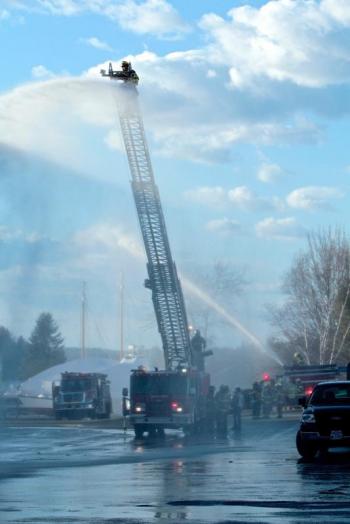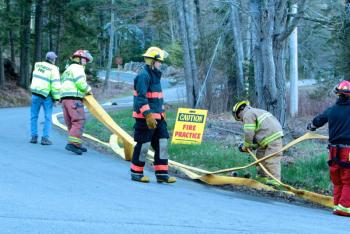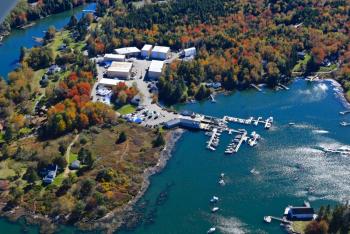Although fires can’t usually be planned, fire departments can plan how to fight them.
That’s what happened Tuesday, April 19, when three area fire departments participated in a coordinated and planned mutual aid fire drill at Hodgdon Yacht Services on Southport Island in what was the first test of the island’s new hydrant system.
Southport Fire Department planned the mutual aid drill with the neighboring departments of Boothbay and Boothbay Harbor with two goals in mind: test the firefighting strategy using Southport’s new hydrant system and test the system’s pumping capabilities using a relay process.
Planning began with discussions at the Southport Fire Department’s March meeting and was helped by the use of aerial photographs taken by well known photographer Robert Mitchell. Mitchell also serves as a volunteer on the fire department. Twenty members of Southport’s department and close to 30 members of other local fire departments participated in the drill, which was scheduled to happen earlier in the month but was postponed due to weather.
In addition to the Southport equipment, Boothbay Fire Department brought two engines, a tank and rescue vehicle and Boothbay Harbor brought a ladder truck.
Southport Fire Chief Gerry Gamage said that a key element of the drill was the placement of the various trucks, each of which carries 1,000 feet of hose. When the new Southport fire hydrants were installed, the department placed markers at a distance of 1,000 feet from each hydrant on the island. Hodgdon Yacht Services is located 2,200 feet from the nearest hydrant and so provided an excellent test situation.
Gamage explained the relay design. “One engine goes to the fire location, one engine goes to the 1000-foot mark and one engine goes to the fire hydrant.” Using a four-way valve (which was also being tested during the drill), water is delivered from the hydrant through the engines and hoses to the fire.
The ability of the firefighting equipment to increase the pressure from the hydrants was another critical part of the drill. “Pressure is 75 pounds per square inch at the hydrant, but we need additional pressure to fight a fire. The new valves, hydrant system and engine relay delivered 170 pounds of pressure and 1,500 gallons of water per minute,” Gamage said, adding that he was “surprised and pleased.” Gamage called the water flow “monumental,” saying “We have a substantial water system.”
Although Southport is surrounded by water, Gamage explained that the fresh water from the hydrants, not salt water, is preferable for firefighting. The department engines are able to draft salt water to use, but the systems need to be flushed because salt water is highly corrosive.
Gamage praised the mutual aid agreements between the towns. Because no one town has a surplus of fire department manpower, the towns have agreed to automatically provide mutual aid for each other, so when there is a confirmed structure fire, all departments are dispatched. “It’s all about people working together.”
The mutual aid agreements also mean that a department’s equipment may be moved to a neighboring town to “stand by” if the neighboring town’s resources are being used somewhere else. In this way, the mutual aid agreements protect the safety of Southport, Boothbay and Boothbay Harbor property owners and residents.
Gamage said the drill had provided the teams with valuable learning; foremost were traffic control issues and the importance of radio contact when relaying trucks. He praised the mutual aid system, saying that “It only works when everyone cooperates and we have a good mutual aid group.”


































